Stages, Symptoms of Periodontal Gums Diseases & their Treatment procedures in Delhi, India.
.
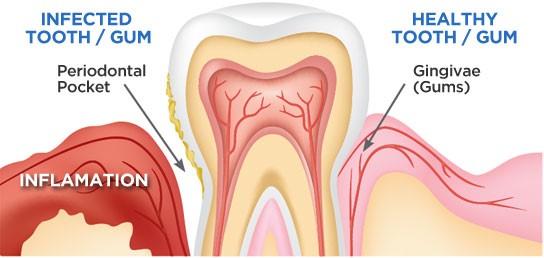
.
Stages & Symptoms of Periodontal Gum Diseases.
Healthy Gums looks like this.
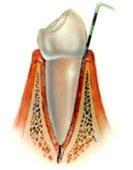
• Gums will hug the teeth tightly.
• Gums will not bleed on probing.
• Gums pocket all measure to a normal 3mm or less.
• No damage to the supporting bone in this stage. Bone height will be normal.
Gingivitis – initial stage of gum disease.
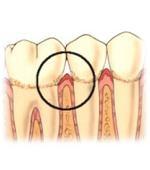
• A mild inflammation of the gums caused by plaque build-up.
• Gums may be red and/or sore. Bleed upon probing.
• Gums will bleed while brushing or during probing.
• Inflamed, sensitive gums
• Possible bad breath/taste.
• Bleeding gums when measured, puffy in appearance and
pockets not greater than 3mm.
• No damage to the supporting bone in this stage.
Early Periodontitis stage.
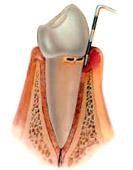
• If left untreated, the gum infection damages the bone and supporting tissues.
• Your gum separates from the tooth and the bone level deteriorates.
• More pronounced gingival bleeding, swelling
• Gums may begin to pull away from teeth
• Bad breath/taste
• Pocket depth measure slightly more than normal at up-to 5mm deep
Moderate Periodontitis.

• Bleeding and swollen gums with pockets that will
• measure up to 6mm and more.
• Teeth may look longer due to gum recession.
• Recession of bone beginning to appear-moderate bone loss.
• Gum boils or abscesses may develop.
• Bad breath, bad taste.
• Teeth may begin to drift and show spaces.
Advanced Periodontitis stage will have symptoms like these.
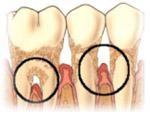
Your gums recede farther and separate. Pus may develop, bone loss continues, and your teeth may loosen or fall out.
• Teeth may become mobile or loose.
• Constant bad breath and bad taste.
• Pockets > 6mm deep.
• some teeth may be extracted (pulled).
• Severe bone loss evidently visible.
Periodontal Gum Disease Treatment in East Delhi, India.
Once Dr. Amit Goswami and Dr. Vandana Goswami at periodontal gum disease treatment clinic in Delhi, identifies the root cause of periodontal disease, then the goals for treatment of gum diseases are set.
- To arrest and control the progress of the gums and periodontal disease
- To leave the periodontal tissues in an easily maintainable state
- If possible, to restore the supporting structures, which include bone, gum tissue and ligaments
.
There are various modalities of treatment by which gum diseases can be treated at Delhi dental center.
- Initial Non-Surgical Gums Treatments – Scaling, Root Planning, oral irrigation and curettage.
- Surgical Gum Treatment — Flap Surgery, Guided Tissue Regeneration, Bone Grafting and Bone Augmentation, These are needed for reducing deep pockets that remain underneath the gum after extensive cleaning sessions
.
In the earlier stages of gum disease, most of the treatment involves scaling, root planning, oral irrigation and curettage (cleaning under the gum margins).
In more advanced cases of gum diseases, the treatment may become more complex. If after removal of the deposits, fairly deep pockets remain, they can be eliminated by a minor surgical procedure. In some cases, flap procedures are performed.
The gum tissue in an area is lifted away from the teeth, all the underlying inflamed tissue and calculus are removed, the bone may then be reconstructed to a proper shape and the gum is then replaced to proper position and sutured. Healing of these procedures takes from seven to 21 days and is usually uneventful, although not without some expected post-operative discomfort.
Antibiotics are sometimes prescribed to treat gum inflammation.
.
Our gum disease treatment clinic in India, is looked upon from more than 90 countries for providing affordable best price low cost painless in-office periodontal gum disease treatment procedures for swollen & bleeding gums, periodontal pocket, receding gums, bad breath, halitosis, mobile teeth, loose teeth, flap surgeries, crown lengthening, dark pigmented gums in Delhi India.

At our Dental Clinic for gum disease treatment we give you an insight picture of the periodontal disease with our intra-oral camera and other digital diagnostic aids and inform you about the stage of gum disease and their upcoming dental symptoms, treatment needed and proper aftercare.
Please feel free to ask us any further questions about Gum Disease treatment
or
for a Free Consultation….
Appointments – The appointment time is flexible and we work all 7 days a week and we will give you your preferred time slot as per your preference.
Same Gum Disease Dentist in East Delhi, Affordable cost, Same location since last 23+ yrs. (est. 2000).
That’s the real beauty of having Periodontal Gum Disease Treatment in East Delhi from Delhi Dental Center.
For More Information



